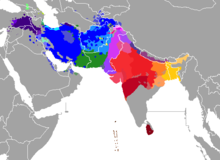Indo-Iranic peoples
Indo-Iranic peoples or Indo-Iranian peoples, is the name given to the group that covers Iranic peoples, Indo-Aryans and Nuristanis today. In the historical sense, it is the group that defined itself as Aryan and eventually split into Iranians, Indo-Aryans and Nuristanis. They spoke the Indo-Iranian branch of Indo-European languages.
 Regions where Indo-Iranic languages are spoken | |
| Regions with significant populations | |
|---|---|
| South Asia, West Asia, Central Asia | |
| 72% of population[1] | |
| 86,15% of population[2] | |
| 98% of population[3] | |
| 79% of population[4] | |
| 71% of population[5] | |
| 74.9% of population | |
| 79.9% of population[6] | |
| 89.9% of population | |
| Languages | |
| Indo-Iranic languages | |
| Religion | |
| Hinduism, Islam, Sikhism, Buddhism, Christianity etc. | |
List of peoples today
changeReferences
change- ↑ "India". The World Factbook. Central Intelligence Agency (United States). "Indo-Aryan 72%, Dravidian 25%, Mongoloid and other 3% (2000)"
- ↑ "Pakistan". The World Factbook. Central Intelligence Agency (United States). "Punjabi 44.68%, Pashtun (Pathan) 15.42%, Sindhi 14.1%, Sariaki 8.38%, Muhajirs 7.57%, Balochi 3.57%, other 6.28% "
- ↑ "Bangladesh". The World Factbook. Central Intelligence Agency (United States). "Bengali 98%, other 2% (includes tribal groups, non-Bengali Muslims) (1998) "
- ↑ "Iran". The World Factbook. Central Intelligence Agency (United States). "Persian 61%, Azeri 16%, Kurd 10%, Lur 6%, Baloch 2%, Arab 2%, Turkmen and Turkic tribes 2%, other 1%"
- ↑ "Afghanistan". The World Factbook. Central Intelligence Agency (United States). "Pashtun 42%, Tajik 27%, Hazara 9%, Uzbek 9%, Aimak 4%, Turkmen 3%, Baloch 2%, other 4%"
- ↑ "Tajikistan". The World Factbook. Central Intelligence Agency (United States). "Tajik 79.9%, Uzbek 15.3%, Russian 1.1%, Kyrgyz 1.1%, other 2.6% (2000 census)"